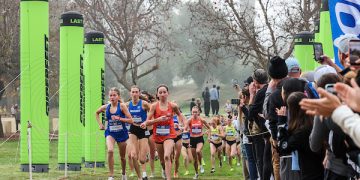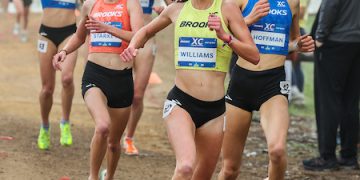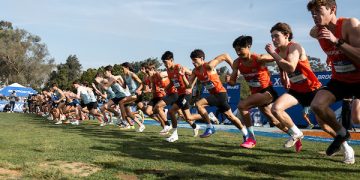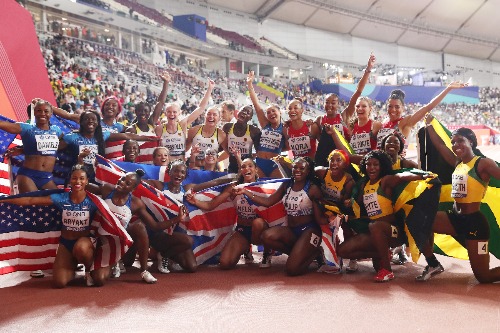
2019 Doha World Championships, 4x100m relay teams, photo by World Athletics
In this second part of Stuart Weir’s feature on Darryl Neita, Stuart spoke to Darryl about her experience as a member of the British 4x100m relay teams.
Darryl Neita talks relays
The GB Women’s sprint relay team famously failed to qualify for the 2012 LONDON Olympics as they were ranked outside the top 16 in the world at the time. A massive embarrassment. Could that to the successes in subsequent years, Darryl Neita joined the squad in 2016 and has collected six medals:
2016 European silver and Olympic silver
2017 World silver
2018 European gold
2019 World silver
2020 Olympic bronze.
In five answers to Stuart’s questions, Darryl explains how it is done.
1. Why has GB been so successful in women’s sprint relays?
Darryl Neita: “We’d been on a bit of a roll since 2016, that’s when I joined the team. We’ve won medals at every championship since. We practice a lot as a team during the year and we have a common focus that we all want medals. Because the relay comes after the individual events in a championship program, it’s a great opportunity to get back on the track as a team and have some fun. We embrace the relay as an opportunity to show off what we can do as a team, putting all our strengths together and coming away with something. We have a lot of trust in one another and I think we demonstrated that in Tokyo when we ran such a fast time in the heat, but unfortunately the final wasn’t as good. But even then, in the final that showed our trust, we didn’t panic and got the baton round. We have such a sense of belief and trust within the team. And we’re looking for medals going forward.”
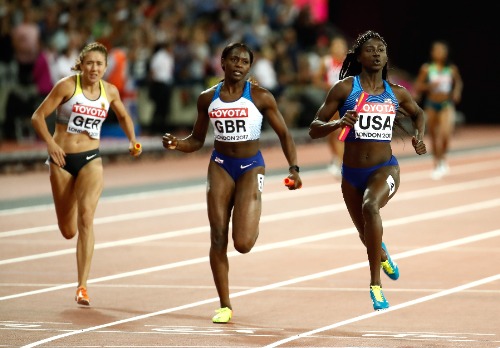
Darryl Neita, British 4x100m relay, London 2017, photo by World Athletics
2. It seems that you cope easily with one person dropping out and someone else coming in.
Darryl Neita: “We all have to be able to run every single leg. I think that’s really important and we practice in that dynamic. Things happen and you can need to make changes at the last minute. We have a common goal and we just want each other to do well, to win a medal. So whoever is strongest at the time takes the leg. There are never any issues with the girls who are not running. They warm up with us and see us into the call room. We want to come away with a successful outcome and we do what we have to, to achieve that. The relay team is developing and really making a mark on the world stage. In fact, we already have made a mark.”
3. What is your preferred leg?
Darryl Neita: “I love the fourth leg and I’ve run out of it at every championship. But I don’t mind running any leg and I always say that to the coaches, And we practice so that everyone can run any leg. I do like running the last leg, getting the baton and just focusing on the finish line. But who knows what the future holds? Management might decide to put me wherever.”
4. What do you enjoy about relays?
Darryl Neita: “I think it has that childhood feel to it. You did it at school and in the first championship you did – London schools, English schools. It reminds me of being really young and it’s very different from the individual event. You are part of a team and you’re warming up together and in the call room, you’re helping each other with the numbers. It’s just different.
It’s always fun going back on the track at the end of a championship. With the 100m usually early in the program, I’m often waiting a week and then I’m out on the track again in the relay. A nice way to close a championship, particularly as every time we’ve closed with a medal. It gives me a good feeling, it’s fun, it’s entertaining. I think it’s fun to watch. We practice so hard. It’s not as easy as it looks because you’ve got someone running towards you, crazy, crazy fast and I’m looking upside down trying to see that tape mark on the track – which you can hardly see – and you got to run.”
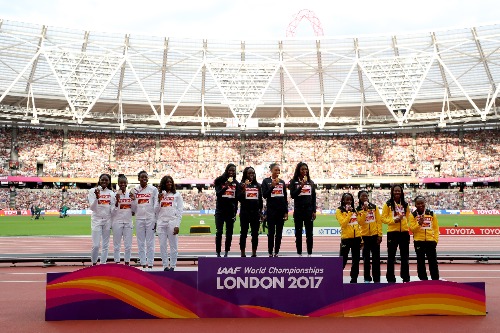
London 2017, 4x100m medal ceremony, photo by World Athletics
5. How does GB beat Jamaica and USA when they have faster individuals?
Darryl Neita: “There’s no denying that they are fast or the flat speed that they’ve got. But we are getting that flat speed now and are improving as a team. We need to make sure that our changeovers are slick because we know that if we can get the baton round at a consistent speed, we’re in with a good chance – particularly with our flat speed increasing. Jamaica and America are super, super quick but we put a lot of emphasis on our practices and our relay changeovers.”
Author
-
We are The Shoe Addicts showing our love of Track and Field among many other sports. We make videos, we have fun doing it. Contact: [email protected]
View all posts


